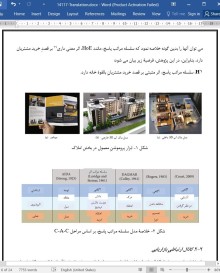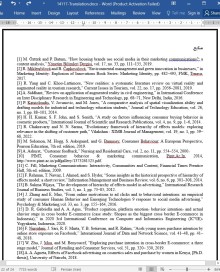
دانلود مقاله اثر واقعیت افزوده (AR)، بر تمایل مشتریان به خرید، در صنعت مسکن
Abstract
Rapid emergence of technology communication has demanded the business organization to adapt with the most optimal marketing approach to ensure long-term survival in the modern business environment. Research on technologies adaptation in relation to marketing were conducted in various sectors in order to study the marketing communication channels in persuading targeted customers to purchase the selling products or utilize the services offered in the market. In contrast, the advancement of technology was not thoroughly harnessed by the property sector, which lagged in adopting the innovative marketing approach to promote their selling house. Accordingly, this research is aimed at investigating the effect of marketing communication channels via the adoption of AR to encourage the intention to purchase among the targeted house buyers. A total of 130 booklets of survey forms were distributed using the self-administered method along with the prompt material of housing design in AR applications. In return, 100 booklets of survey forms were received. As a result, the findings indicated that AR application as a marketing communication channel has an impact on the intention to purchase among potential house buyers. It is expected that AR technologies would create a new norm with extraordinary modification and advancement to promote housing projects and provide guidance to the developer. This initiative is able to improve their marketing communication, thus attracting house buyers based on their interests.
1. Introduction
Housing industry is one of the major sectors of the construction industry, which includes the development, construction, and sale of houses. It also refers to the housing market that indicates the supply and demand for houses [1]. Currently, provided that consumers purchase houses as living space and investment, the advancement of technology has caused the industry to change their marketing strategy to increase the success in promoting their selling housing projects to the targeted buyers. In this phenomenon, housing developers face increasingly difficult challenges, such as continual growth, new designs, and new presentation skills to match consumer demands.
In the current competitive business environment, the survival and advancement of an undertaking cannot be isolated from the presence of exact and point-by-point customer data. Hence, diverse types of the marketing communication channel are utilized to approach buyers, which is aimed at conveying item data to target buyers and reaching an agreement with the company. According to Miklenčičová and Čapkovičová [2], buyers would be more convinced and faithful through the advertisement of a total encounter that goes beyond a basic buy, which increases confidence in the company recommendation. Hence, the most imperative objective of marketing communication channels includes the formation and alteration of consumer behavior through the impact of items, costs, and dissemination.
7. Limitations and Future Research
This study has several limitations, which provides an avenue for additional research in terms of purchasing behavior in relation to marketing in the housing sector. To note, the response hierarchy could be summarized into three main phases: cognitive, affective, and conative. This study excludes the conative phase as the aim of this study is to investigate the prepurchase behavior in the context of the housing sector. The purchasing behavior for house is excluded as this study did not represent any current selling house, but the house model in the AR application is chosen randomly. Other than that, this study would like to explore the potential of AR technology as an alternative marketing communication channel in promoting the selling house among the housing developers. Thus, similar research could be executed by considering the conative phase and develop the house model based on the current selling house. Furthermore, the current study is cross-sectional, whereas further research could explore qualitative and longitudinal approaches.
In terms of statistical analysis, this study employed correlation analysis in order to test the hypotheses as well as examine the strength of relationship between the variables (response hierarchy and AR technology with intention to purchase). Consideration for further study could be extended by employing regression analysis which could indicate the items that mostly influence the purchasing intention among the potential house buyers.
To note, the data for this study was collected prior to the COVID-19 coronavirus pandemic, which hindered this study to collect more data. Based on the Cochran formula (t = 1:96, S = 0:5, d = 5%), this study planned to distribute around 400 sets of survey booklets. However, due to several travel restrictions by the Malaysian government, this study was only able to distribute 130 sets of survey booklets. Fortunately, the distributed and returned sets of survey booklets were sufficient and appropriate to generalize the data that represent the whole population based on a similar approach adopted in previous research (t = 1:96, S = 0:5, d = 10%). In addition, the COVID-19 coronavirus may have influenced the attitudes of respondents involved in this study. Hence, this study could be repeated by extending the sample size and assess the prepurchasing or purchasing behavior in a normal daily life scenario.
H1: response hierarchy has positive impact on intention to purchase among the potential house buyers.
H2: AR technology application has a positive effect on intention to purchase among the potential house buyers.
H1: سلسله مراتب پاسخ، اثر مثبتی بر قصد خرید مشتریانِ بالقوۀ خانه دارد.
H2: کاربرد فن آوری AR، اثر مثبتی بر قصدِ خرید در خریدارانِ بالقوۀ خانه دارد.
1. مقدمه
2. بررسی منابع
2-1. ارتباطات در بازاریابی
2-2. کانال ارتباطیِ بازاریابی
2-3. مدل مفهومی تحقیق
3. روش ها
3-1. ابزار تحقیقاتی
3-2. جمعیت و پاسخ دهنگانِ هدف
3-3. جمع آوری داده ها
4. نتایج و بحث
4-1. پروفایل پاسخ دهندگان
4-2. تحلیل پایاییِ ابزار تحقیق
4-3. آزمون فرضیات
5. بحث
6. نتیجه گیری
7. محدودیت ها و تحقیقات آتی
دسترسی به داده ها
عدم تضاد منافع
تقدیر و تشکر
منابع
1. Introduction
2. Literature Review
2.1. Marketing Communication.
2.2. Marketing Communication Channel
2.3. Research Conceptual Model
3. Methodology
3.1. Research Instrumentation
3.2. Population and Targeted Respondents
3.3. Data Collection
4. Results and Discussion
4.1. Respondent Profiles
4.2. Reliability Analysis of Research Instrument
4.3. Hypothesis Testing
5. Discussion
6. Conclusion
7. Limitations and Future Research
Data Availability
Conflicts of Interest
Acknowledgments
References
این محصول شامل پاورپوینت ترجمه نیز می باشد که پس از خرید قابل دانلود می باشد. پاورپوینت این مقاله حاوی 18 اسلاید و 6 فصل است. در صورت نیاز به ارائه مقاله در کنفرانس یا سمینار می توان از این فایل پاورپوینت استفاده کرد.
در این محصول، به همراه ترجمه کامل متن، یک فایل ورد ترجمه خلاصه نیز ارائه شده است. متن فارسی این مقاله در 6 صفحه (1800 کلمه) خلاصه شده و در داخل بسته قرار گرفته است.
علاوه بر ترجمه مقاله، یک فایل ورد نیز به این محصول اضافه شده است که در آن متن به صورت یک پاراگراف انگلیسی و یک پاراگراف فارسی درج شده است که باعث می شود به راحتی قادر به تشخیص ترجمه هر بخش از مقاله و مطالعه آن باشید. این فایل برای یادگیری و مطالعه همزمان متن انگلیسی و فارسی بسیار مفید می باشد.
بخش مهم دیگری از این محصول لغت نامه یا اصطلاحات تخصصی می باشد که در آن تعداد 48 عبارت و اصطلاح تخصصی استفاده شده در این مقاله در یک فایل اکسل جمع آوری شده است. در این فایل اصطلاحات انگلیسی (تک کلمه ای یا چند کلمه ای) در یک ستون و ترجمه آنها در ستون دیگر درج شده است که در صورت نیاز می توان به راحتی از این عبارات استفاده کرد.
- ترجمه فارسی مقاله با فرمت ورد (word) با قابلیت ویرایش و pdf بدون آرم سایت ای ترجمه
- پاورپوینت فارسی با فرمت pptx
- خلاصه فارسی با فرمت ورد (word)
- متن پاراگراف به پاراگراف انگلیسی و فارسی با فرمت ورد (word)
- اصطلاحات تخصصی با فرمت اکسل



